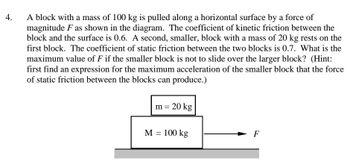Question
Please asap

Transcribed Image Text:4.
A block with a mass of 100 kg is pulled along a horizontal surface by a force of
magnitude F as shown in the diagram. The coefficient of kinetic friction between the
block and the surface is 0.6. A second, smaller, block with a mass of 20 kg rests on the
first block. The coefficient of static friction between the two blocks is 0.7. What is the
maximum value of F if the smaller block is not to slide over the larger block? (Hint:
first find an expression for the maximum acceleration of the smaller block that the force
of static friction between the blocks can produce.)
m = 20 kg
M = 100 kg
F
Expert Solution
This question has been solved!
Explore an expertly crafted, step-by-step solution for a thorough understanding of key concepts.
Step by stepSolved in 3 steps with 9 images

Knowledge Booster
Similar questions
arrow_back_ios
arrow_forward_ios